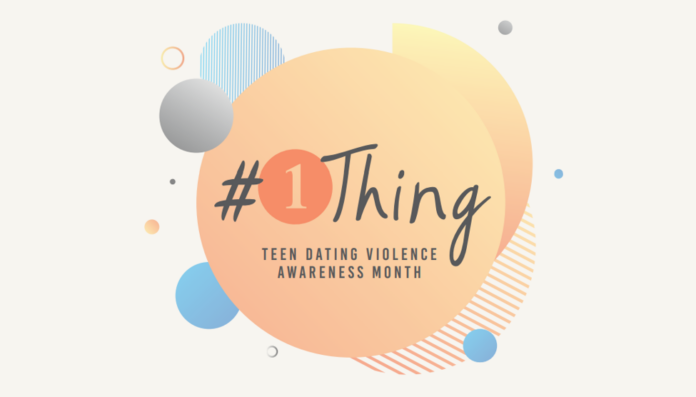By: Amy Jenkins
Publisher: SIECUS
Date: Unavailable
February is Teen Dating Violence Awareness Month (TDVAM). We know teen dating violence is entirely too common. And we know that experiencing abuse can have long-lasting, devastating impacts on a young person’s physical and mental health.
But…what else do we know about teen dating violence? How common is it? How can we help to prevent it? While we may tend to only picture this type of violence in the context of adult relationships, we know that simply isn’t the case.
That’s why Loveisrespect’s mission for TDVAM 2020 is for everyone — adults, parents, teens, educators — to learn #1Thing (pronounced “One Thing” or “Hashtag One Thing”) about teen dating violence. So, we’ve done a bit of research and compiled some information to get you started. Keep reading to learn one thing (or maybe a few!) about TDVAM.
Teen Dating Violence, Defined
The Centers for Disease Control and Prevention explains that Teen Dating Violence can take a number of forms:
- Physical violence is when a person hurts or tries to hurt a partner by hitting, kicking, or using another type of physical force.
- Sexual violence is forcing or attempting to force a partner to take part in a sex act, sexual touching, or a non-physical sexual event (e.g., sexting) when the partner does not or cannot consent.
- Psychological aggression is the use of verbal and non-verbal communication with the intent to harm another person mentally or emotionally and/or exert control over another person.
- Stalking is a pattern of repeated, unwanted attention and contact by a partner that causes fear or one’s safety or the safety of someone close to them.
In the U.S., one in three young people will experience physical, sexual, or emotional abuse from a partner before they’re 18.
Where We Are
First, let’s note that there are many organizations working to prevent teen dating violence and aid survivors. Make sure to check out Loveisrespect, Futures without Violence, and the National Domestic Violence Hotline.
Even still, teen dating violence is not being talked about nearly enough. We need to spread awareness to make sure young people are equipped with the information they need to understand and address abusive relationships. And I bet you can guess where this is going…
That’s right: sex ed!
Comprehensive sex education can provide young people with the exact information and skills they need to understand and address TDV before they become teenagers. It includes topics and lessons on healthy relationships, identifying abusive behavior, communication, consent, and boundary setting/respecting. As outlined by the National Sexuality Education Standards, this type of instruction can teach young people to:
- Demonstrate effective ways to communicate personal boundaries and show respect for the boundaries of others
- Identify parents and other trusted adults they can talk in case they are experiencing abuse or violence
- Describe characteristics of healthy and unhealthy romantic or sexual relationships
- Explain how media can influence one’s beliefs about what constitutes a healthy relationship
- Advocate for safe environments that encourage dignified and respectful treatment of everyone
Every young person deserves sex education that includes these lessons, which are foundational for understanding healthy relationships and can actively aid in the prevention of teen dating violence.
Unfortunately, our government is currently funding abstinence-only-until-marriage programs, also called “Sexual Risk Avoidance (SRA),” which provides shaming, inaccurate lessons to young people. Decades of research show that these programs do not work and can actually harm young people.
That’s in part because SRA lessons enforce gender stereotypes and heteronormative values. In these curricula, young people are taught that boys are programmed to persistently seek sex with girls and girls are responsible for navigating the behaviors of boys.
For example, one such lesson focuses on “crockpots and microwaves.” It teaches students that girls are like crockpots because they “heat up” more slowly and boys are like microwaves because they “get hot” quickly. These types of lessons also often teach girls that they should dress “modestly” so as not to “excite the boys.”
In both of these examples, boys’ sexual advances (regardless of whether or not they are consensual) are justified. Meanwhile, girls are taught that the onus for navigating these situations safely is completely on them. Not only do these lessons inherently exclude young people’s diverse gender identities and sexual orientations, but they can instill harmful messages of victim blaming that can further perpetuate TDV.
We must do better by all of our young people by teaching them about healthy relationships and consent rather than promoting these shaming messages.
What We Can Do
Some states have some kind of policy regarding instruction on healthy relationships and dating violence prevention — and that’s great! But while we have observed a positive trend among states as they start to introduce such policies, we still have plenty of work to do.
Here are some action items for TDVAM 2020 and beyond:
- If you or someone you know is experiencing teen dating violence, Loveisrespect has resources that can guide you.
- Find out what is (or is not) being offered in your community in terms of healthy relationships education. Then, you can utilize our Community Action Toolkit (CAT), which has the tools you need to build support for comprehensive sex education policies and institute (or defend) effective programs in your community.
- Learn more and talk to the teens and parents in your life about the importance of healthy relationships, recognizing types of abuse, affirmative consent, and setting/respecting boundaries.
- Check out Loveisrespect’s Teen Action Guide, Helpers Action Guide, Respect Week Action Guide, and other resources to participate in Teen Dating Violence Awareness Month. Use the hashtags #1Thing and #TDVAM2020 to join in the conversation on social media.
- Call on Congress to support The Real Education for Healthy Youth Act (REHYA), which would create the first-ever federal funding stream for comprehensive sexuality education (which, by definition, includes healthy relationships and consent education) in the U.S. and eliminate funding for failed, abstinence-only, “Sexual Risk Avoidance” programs.
As a bonus, check out this uplifting piece about an advocate who is working to prevent intimate partner violence: Can a Philly-area high school course help prevent intimate partner violence? ‘Coach V’ thinks so.
Source: https://siecus.org/teen-dating-violence-sex-ed-is-a-prevention-strategy/
Comment: I chose this article because it provides interesting insight on abstinence based programs I had not thought of before. I had simply thought of abstinence based Sex Education programs as ineffective. In reality, these programs are actually harmful. They hurt the development of those students who are subjected to it and this requires a mass defunding of ridiculous programs that do not accomplish the goals we need to reach in Sex Education.




